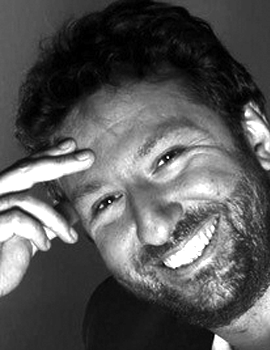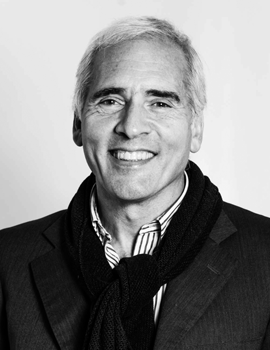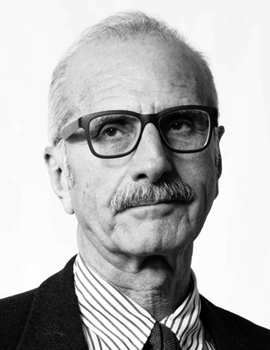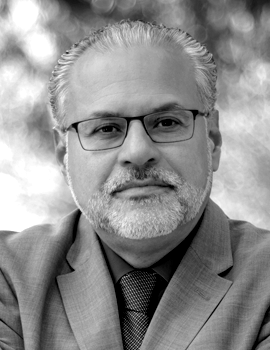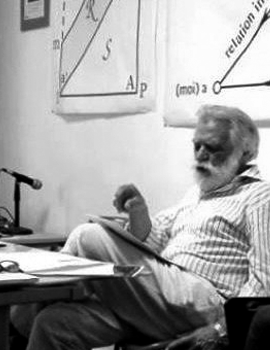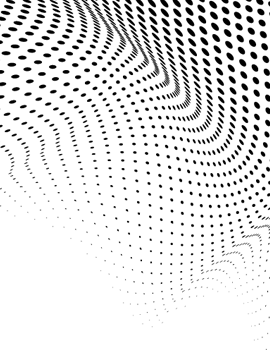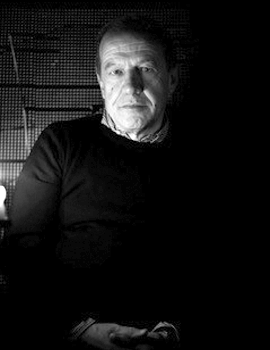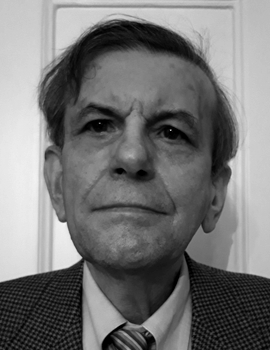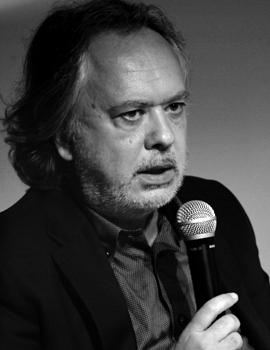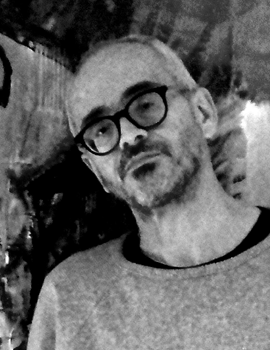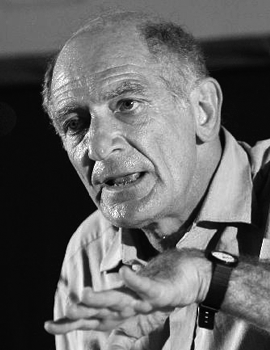From a Community of Citizens to a Network of Users: Group Life in the Twenty-First Century
In How Will Capitalism End?, the sociologist Wolfgang Streeck argues that in the neoliberal period, “communities of citizens” have been replaced with “networks of users”, implying that neoliberalism has refashioned the meanings of both group and individual. In this presentation, I attempt to specify in what sense this statement is true, and then to re-examine Freud’s Group Psychology and the Analysis of the Ego in ligh to fit. The first section will look at the broad shifts in group life during the neoliberal period. The second will look at Theodor Adorno’s hypothesis of a new anthropological type that appeared in the Fordist period as a replacement for the classic Freudian subject. While I believe that Adorno’s conception of the changes wrought by the culture industry largely hold up, in the third section I will try to get more specifically at changes in subjectivity that go beyond Adorno’s thesis, and which circle around the concept of“rational paranoia.” I’ll then close by returning to the Group Psychology essay.
Group Life in the Twenty-First Century
In the last forty or so years, the western capitalist world has undergone a massive shift in the structures of group life. Political scientists and commentators have come up with various ways in which to describe this shift, including Peter Mair’s “void,” Colin Crouch’s “post-democracy,” and most recently Chris Bickerton and Carlo Invernizzi Accetti’s “technopopulism.” The basic point in all is that the classic intermediary structures of society, including unions, churches, parties, membership organizations, and other civic associations, have all withered in such a way as to decouple citizens from the leaders and institutions that supposedly represent them. This is represented straightforwardly in things like union density—in the United States, it’s at 10.3%, and a dismal 6.3% in the private sector—but it’s also clear in falling and stagnant voter participation. A notable exception to this trend was the 2020 general election in America, which saw a 10% bump in voter turnout. We could perhaps discuss what this means, but my sense is that it was largely the fruit of the media insanity of the last five years, or what the hosts of the global politics podcast Aufhebunga Bunga call “neoliberal order breakdown syndrome.”
The various movements and leaders associated in this time with the term populism—including both Bernie Sanders and Donald Trump in the US, both Jean-Luc Mélenchon and Marine Le Pen in France, Jeremy Corbyn and Momentum in England, Pablo Iglesias and Podemos in Spain, Viktor Orbán in Hungary, and the Five Star Movement and Lega in Italy—though they have both been a symptom of broader neoliberal decay as well as a challenge to it, have not fundamentally changed this situation of social disintermediation and have in many cases fell prey to its logic. As Paulo Gerbaudo writes in The Digital Party, the organizational infrastructure of many of these populist instances, including Podemos and Five Star, is extremely thin and primarily online. In Gerbaudo’s words,
The digital party presents itself as an organisation that is going to do away with the serious limits of representative democracy, and the distance it has created between citizens and their representatives. It bears the promise of disintermediating politics, making it more similar to immediacy, interactivity and instantaneity of social experience in the digital era, while doing away with a number of middlemen—bureaucrats, consultants, spin doctors—suspected of being responsible for many of the ills of contemporary politics and the way it distorts the authentic will of the people.[1]
The problem of course is that the purported “middlemen” getting in the way of political participation are traditionally the structures whereby citizens affected the political order. As the classic membership-based organizations of the post-war period have declined in importance—to be replaced by top-heavy NGOs that are, by design, less responsive to the constituencies they supposedly serve, more influenced by networked elites, and ultimately a form of insulation for rather than a pressure upon politicians—it’s true that these intermediary structures have become distorting, but that doesn’t mean mediating institutions themselves ought to be eliminated. Indeed, in their absence, Gerbaudo continues, we are left with a rather concerning phenomenon: “a highly reactive [and highly online] ‘superbase’ becoming allied with a charismatic hyperleader at the expenses of intermediate strata.”[2]
Leaders of the more traditional type, even megalomaniacal ones, worked within organizational structures to gain control of key committees and respond to and work to direct the will of the organization’s members. Even in corrupt instances, like those of Tammany Hall or the political machine of the first Mayor Daley, there is a link, however manipulated and coerced, between leaders and citizens or members, such that leaders must respond to the often transactional constraints of the people they seek to represent. In its disintermediated form, leaders do not really represent the interests of others; nowhere was the much maligned Trump base voting on what policies their leader should or should not support. Indeed, I would say that this base—and I mean the true believers, not the traditional Republicans who held their nose or the evangelicals who expected a certain number of judiciary appointments—did not really expect anything of Trump in terms of policy or concrete gains, save for the ever more psychotic indignation of liberal elites.
This works the other way as well: in addition to having no respect whatsoever for his base, Trump also had very little control over them. His adolescent Tweeting did not comprise clear directives; indeed, his supporters often acted in response not to his actual actions but to the machinations of online forums, which might have had little to do with Trump the real person.
I would argue, however, that the most important consequence of political disintermediation is not the birth of the hyperleader/superbase dynamic but rather the basic political unresponsiveness of the present, the cold and hardened reality from which the digital swarm offers a fantasied escape. The sociologist Theda Skocpol offers an illuminating explanation of implications of the sea change in America’s civic universe (and please forgive the long quote, but I think it’s a great example):
Imagine for a moment what might have happened if the GI Bill of 1944 had been debated and legislated in a civic world configured more like the one that prevailed during the 1993-94 debates about the proposal for national health insurance put forward by the first administration of Bill Clinton. This is not an entirely fanciful comparison, because goals supported by the vast majority of Americans were at issue in both periods: in the 1940s, care and opportunity for millions of military veterans returning from World War II; in the 1990s, access for all Americans to a modicum of health insurance coverage…. In the actual civic circumstances of the 1940s, elites did not keep control of public debates or legislative initiatives. Instead, a vast voluntary membership federation, the American Legion, stepped in [to] draft one of the most generous pieces of social legislation in American history; in addition, thousands of local Legion posts and dozens of state organizations mounted a massive public education and lobbying campaign to ensure that even conservative congressional representatives would vote for the new legislation. Half a century later, the 1990s health security episode played out in a transformed civic universe dominated by advocacy groups, pollsters, and big-money media campaigns. Top-heavy advocacy groups did not mobilize mass support for a sensible reform plan. Hundreds of business and professional groups influenced the Clinton administration’s complex policy schemes and then used a combination of congressional lobbying and media campaigns to block new legislation. The American people, especially low-income families, ended up without the desired extension of health coverage. American citizens recoiled in disgust at the expense and gridlock of the whole episode.[3]
In the terms of Wilfred Bion, one might say that traditional groups have been cut off from any meaningful way to alter their social situation, i.e. that they have been robbed of “work,” and for this reason they have either fallen into self-destructive forms of “basic assumption” or else fallen apart altogether.
New Types of Human Being
In 1950, Theodor Adorno, R. Nevitt Sanford, Else Frenkel-Brunswick, and Daniel Levinson published The Authoritarian Personality, a text that has received renewed interest since 2016. In the book the authors delineate a distinctively authoritarian type with nine characteristics: an adherence to conventional beliefs, submission to authority, aggressiveness, what they call anti-intraception (or a hostility to subjectivity), superstition and stereotypy, an attachment to toughness, cynicism, projectivity, and a preoccupation with modern sexual expression. Though many have been quick to read Trump supporters into this characterization, Peter Gordon has noted that, for Adorno at least, this list of characteristics does not so much define a specific kind of person as it does a pervasive tendency in the personality structures of late capitalist subjects.[4]
This is clear in Adorno’s numerous references to a “new anthropological type” or “new type of human being” that had come to replace the classic Freudian subject of repression. To briefly summarize an argument from my book, Death and Mastery, I believe the best way to make sense of this new type of human being is in relation to the Frankfurt School’s basic thesis about the culture industry, which is that the range of media that appeared in the twentieth century (radio, film, television) had come by mid-century to exercise a new form of social control on capitalist subjects that supplemented their exploitation in the sphere of work by inculcating an adherence to the status quo in the sphere of so-called “free time.” The culture industry does so by providing a form of immediate, uncomplicated gratification that stifles critical capacities—direct id satisfaction, one might say, that lowers ego and superego intensity.
Many commentators on the Frankfurt School, such as Peter Uwe Hohendahl, see these thoughts about the culture industry as tied specifically to the Fordist period of mass production. But the flexibilization of production and broader changes of what is called the “neoliberal” period have been changes in inequality, productive capacity, and the nature of work, not changes in the culture industry—which, I would argue, has held together with remarkable continuity. To my mind, “that we watch Emma Stone instead of Greta Garbo, that our kids know the new Disney characters instead of the old ones, that we’re all constantly looking at screens instead of reserving a few hours after work for them—none of this adds up to any qualitative break.” Our conditions of work and prosperity have changed dramatically since Adorno and Horkheimer’s time, but we are still imbibing the same cultural slop.
With, however, three important differences—most of which I would nonetheless argue are foreshadowed by Adorno and Horkheimer. First, while the culture industry today still thrives on the blockbuster with mass appeal, it caters quite effectively to increasingly niche markets, thanks amongst other things to improvements in so-called “big data” and predictive algorithms. “Something is provided for everyone so that no one can escape; differences are hammered home and propagated. The hierarchy of serial qualities purveyed to the public serves only to quantify it more completely. Everyone is supposed to behave spontaneously according to a ‘level’ determined by indices and to select the category of… product manufactured for their type.”[5] Those last three sentences, by the way, are from Adorno and Horkheimer’s Dialectic of Enlightenment.
Second, and relatedly, the culture industry has benefited from the narrow technological development we have seen under neoliberalism. As Anton Jäger and Daniel Zamora note in a recent article on automation, “recent technological advances have been concentrated in very specific areas of human life—enclosed, more or less, on our smartphone screens—and have failed to ripple through the entire production process, driving breakthroughs in adjacent fields.”[6] In the words of Silicon Valley guru Peter Thiel, “we were promised flying cars, and all we got was 140 characters.”
Third, the culture industry has absorbed domains that have traditionally been separate from culture, most notably politics—and maybe academia, but that’s a subject for a different talk. The hollowness of political life, its insulation from anything but the media and nonprofit worlds, its essentially non-material and personal orientation, its focus on the competence and personality of leaders rather than their ability to deliver concrete goods, the silly tribalism wherein both sides see the other as morally inferior… all of this speaks to the slow but assured descent of politics into but one mode of the culture industry. Once again, Adorno and Horkheimer saw where things were heading: “the ruthless unity in the culture industry is evidence of what will happen in politics.”
When we combine these three ways in which the culture industry has further penetrated into our lives with the growing economic precarity of the neoliberal era, what do we get? Do these changes amount to the forging of a new “new anthropological type,” or rather a quantitative extension of Adorno and Horkheimer’s thesis? I would argue, though here I’m very willing to be convinced otherwise, that this all amounts merely to quantitative extension: that with niche consumption, technological extension, and the infection of previously separate spheres, the culture industry has made us even more attached to fleeting pleasures, unthinking and lacking in sociability, and ultimately less willing to challenge the constraints of an increasingly absurd status quo. That all of these things have happened while basic material benefits and security have been eroded all tracks.
Rational Paranoia
As far as the history of subjectivity goes, however, I don’t think the story ends there: there is something fundamentally new about the shaping of psyches in the neoliberal period, and it has to do with the specific form of dominance that pharmaceutical companies have over our lives. (Here I will admit knowing much less about the European context. My comments are restricted to the American history, but I’d be curious to know how this has played out in other national contexts.)
Even in the post-war period, of course, Big Pharma was quite powerful, but their behavior was similar to that of tobacco companies: they knew their uppers and downers were bad for people (and were furthermore, unlike in the case of cigarettes, being abused), but they pretended not to know and suppressed any information that might be damaging to sales. Their clandestine attempts to replace their best sellers with less harmful substitutes, along with the internal jockeying for niche market dominance, explain the appearance of so many new drugs during this period: amphetamine, dextroamphetamine, methamphetamine, and methylphenidate (Ritalin) in the case of uppers; and meprobamate (Miltown), barbiturates, Quaaludes, and benzodiazepines in the case of downers.
By the end of the 60s, thanks to the increasing suspicion of Big Pharma, the bureaucratic reshuffling following Harry Anslinger’s retirement from the Federal Bureau of Narcotics, and the growing reaction to the counterculture, the Nixon administration proposed sweeping changes in drug regulation, resulting in the Controlled Substances Act in 1970. Pharma adapted quite easily to the new environment, however, and in cozying up to regulatory agencies and working in even more concerted fashion to shape medical practice, birthed a new conception of health itself.
In the 50s, you went to the doctor when you were sick; today you go for regular maintenance and monitoring of risk factors. The anthropologist Joseph Dumit describes this as the shift from an “inherent health” to an “inherent illness” model.[7] Though the latter may well be more medically valid, it is also a paradigm within which pharmaceutical companies conveniently do quite well. When the target of drug treatment is not sickness but “chronic illness” or mere risk, and when the alleviation of that risk is defined through large randomized control trials that amplify small treatment effects (such that pills that do not work for most people are deemed necessary precautionary measures[8]), Big Pharma unsurprisingly makes a handsome profit. The aim is simply “not to cure people or to identify those who should be cured, but to grow the number of new prescriptions as much as possible.”[9]
This was true in the post-war period as well, but the means of doing so today produce what Dumit calls “rational paranoia.”[10] Since the target of drug treatment is often not actual sickness but risk, illness becomes something you don’t necessarily feel—something that you believe you have to the extent that you have submitted to the proper authorities on the prevention of risk. Those authorities are not doctors but the companies themselves: indeed, in direct-to-consumer advertising of prescription drugs (something that only exists in America and New Zealand), patients are encouraged to challenge their doctors, to press them with information retrieved from advocacy websites that are mostly sponsored by pharma itself. This combination of imperatives produces what Dumit calls “the expert patient”: the responsible, bordering on obsessive, judge and executor of industry-fashioned expertise; the self-made island of reason in a sea of medical disorganization.
For this cagey monad, immediate reality is not to be trusted; the truth lies elsewhere. The inherent illness paradigm encourages the disregard of one’s own feelings and the incorporation of medical facts into one’s life. The indiscriminately applied depth hermeneutic of paranoia is thus wedded to a thoroughgoing belief in “the science” and embedded in the structure of everyday life: if you are not taking the pills that address the sickness that you do not yet feel or even have, if you are not scouring the internet for information that you will bring to your doctor about your own condition, if you are not reading about the latest health trends and applying them to your life, then you are a dupe—undoubtedly the worst kind of subject to be today.
Dumit focuses exclusively on health, but it’s difficult not to see his basic considerations as relevant to many other spheres of life—finances, media, relationships. In all, you have to go beyond deceptive surface appearances to the hidden truth of things: the underlying trends behind market behavior, the real occurrences behind corporate media cover-ups, what men and women really want. We can recognize the clearly degraded forms of this phenomenon (“One simple trick to being a millionaire!”), but the thing itself is undeniable: of course our medical system is going to fail us, of course our financial system is rigged, of course the media is lying to us. All of this is true, as far as it goes—thus, rational paranoia.
A reinforcing benefit of rational paranoia is participation in what we can call the “inside dope” community. The inside dope community is one built on the idea that truth is always hidden beneath the surface: a community of nootropic enthusiasts, of Reddit stock traders, of internet gamers, of Facebook wine moms, and yes, of Russiagate fanatics and QAnon followers. Once again, Adorno was quite prescient here:
Such systems furnish whoever is deprived of the continuity of judgment and experience with schemata for coping with reality. These latter certainly do not approximate reality but compensate for the anxiety of what cannot be grasped. Consumers of psychotic ready-mades feel sheltered by all those similarly isolated, who are bound together in their solitude by a common delusion under conditions of radical social alienation. As soon as it transcends immediate interests, the narcissistic gratification of leading a secret life and belonging to a select group exempts one from reality testing, which according to Freud was the foremost task of the old ego.[11]
If there is something fundamentally new about subjectivity in the neoliberal period, something that goes beyond the previous considerations regarding the new anthropological type, it is that culture industry fantasy is no longer simply an escape or distraction from reality, a bit of dosed pleasure that helps you bear the drudgery of work, but rather that it is increasingly compelled by social reality as the only means of really engaging that reality, given the proliferation of ways in which rational paranoia is inculcated.
Group Psychology Today
I have thusfar described a present in which group life is every where thrown back into what Bion called basic assumptions: being unable to affect the status quo of increasing inequality, to thepoint where some speak of “neo-feudalism,” groups are thrown back on themselves, either tocohere in some essentially fantasied sense or fall apart altogether. This development wasprepared for by changes in subjectivity described by Adorno and others, and reinforced furtherby the development of rational paranoia, a socially compelled and ultimately rational form of psychotic relating that is increasingly the logic of group life.
What was most remarkable to me in re-reading Freud’s Group Psychology essay in preparationfor this talk was how quickly and decisively he moves away from Gustave Le Bon and WilliamMcDougall, which serve as his points of departure, toward a much cleaner and more positiveconception of group life. In essence, all he takes from his literature review is that groups areintense in emotion and inhibited in intellect, which serves as the basis for his assertion that in agroup, individuals identify with each other in their ego in putting one and the same object in theplaceoftheirego-ideal.10Thisisaneatformulation,itfitsnicelywithhisconceptionsofloveandhypnosis, but it hardly explains the panic-stricken, wildly credulous and irrational mob mentality that so concerned Le Bonand McDougall.
And to Freud’s credit, I believe: for one, analytically he is surely correct that before we cananswer the question as to why groups behave in the way that they do, it’s necessary first tounderstand how they cohere in the first place. And normatively, despite his own membership in the professional classes and essentially bourgeo is sensibility, I think Freud sniffed out strand so felitist denigration that ran counter to his liberal values. Forget the violent mob, says Freud: if we want to understand group life, let’slook at the Church and the Army. We could also,I would add, look just as well to the mass political party. In all I think Freud is right to think of group life asbearing a more subtle influence on the individual than envisioned by Le Bon and McDougall: yes, emotional investment is involved and leaders serve a psychological function, but we’reultimately talking about individuals participating in functional groups—which individuals are ofcoursewonttodo.
If the previous thoughts about the decline of associational capacity and transformations ofsubjectivity hold, then it would make sense that Le Bon and McDougall’s observations on the negative and psychotic elements of group life now see more pertinent than Freud’s, but not for the reasons that either author put forth. Le Bon was interested in a kind of Durkheimian collective effervescence, where in otherwise stable consciousnesses are swept up into a sea ofunreason by contagion. If the dangers of populism today were really captured in Le Bon’s descriptions, the Capitol riot on January 6th wouldn’t have been strangers wandering aboutaimlessly taking selfies. Groups today simply don’t coherewith much intensity; they are in factquite easily fractured and dissipated. Networks can be disintegrated and reconfigured as needed; all the better if increasing the surveillance capacity of the state is involved.
Neither are the “users” linked through such networks organized around a common ego-ideal.What sense does it make to say that Trump served in the role to which Freud attributes thefunctions of self-observation, moral conscience, and repression? Contemporary “hyperleaders”do not organize experience in the manner that the fascist agitator does according to Leo Lowenthaland Norbert Gutermanin Prophets of Deceit. There are the classic dog whistles and xenophobic explanations that attempt to square the circle, but the super base is not finding confused “satisfaction in the ego ideal which has been differentiated out of the ego.” The leader is less an actual leader than a needed component part of a pre-existing paranoid fantasy. In this, I think Donald Meltzer’s descriptions of the compartments of what he calls the claustrum, wherein “leaders” are composite part-objects in a psychotic fantasy, make more intuitive sense of the contemporary hyperleader.
This, I would argue, is also why antifascism is not only a misunderstanding of and thus adistraction from our current political predicament but also a positive exacerbation of currenttrends. Fascism required functional political institutions that could be captured; antifascismtoday, in conceptualizing the threat to democracy as an organized political tendency that must be countered directly and confrontationally, not only participates in the disorganization that is the dominant feature of political life today but also inflames the animating fantasies of various rational paranoids, from the right-wingers that are their target to the centrist civility mongers.
Antifascists are correct that there are pernicious and organized anti-democratic forces out there, but they misunderstand both who they are and how we counter them. The threats to democracytoday do not come from the unwashed and backward masses; they come from the capitalistclass and the executors of their interests. And the way to counter them is not by confrontingthem in the street—or even worse, cheering on the security state to track and punish them—asa means of disorganizing their ranks; it is rather to begin again the old task of organizing constituencies into groups that both bear real representative structures and are capable ofeffecting some real change on existing political structures; to give groups work, in Bion’s sense.Without rebuilding the intermediary institutions of democracies, the descent into a society ofrational paranoia—of quick fixes and one small tricks, of scorn for the dupes over there, of thinconnection to others throughthe media of psychotic ready-mades—will continue apace. As the copper wiring is stripped out and we all bunker down for the heat, it will be quite the display.






